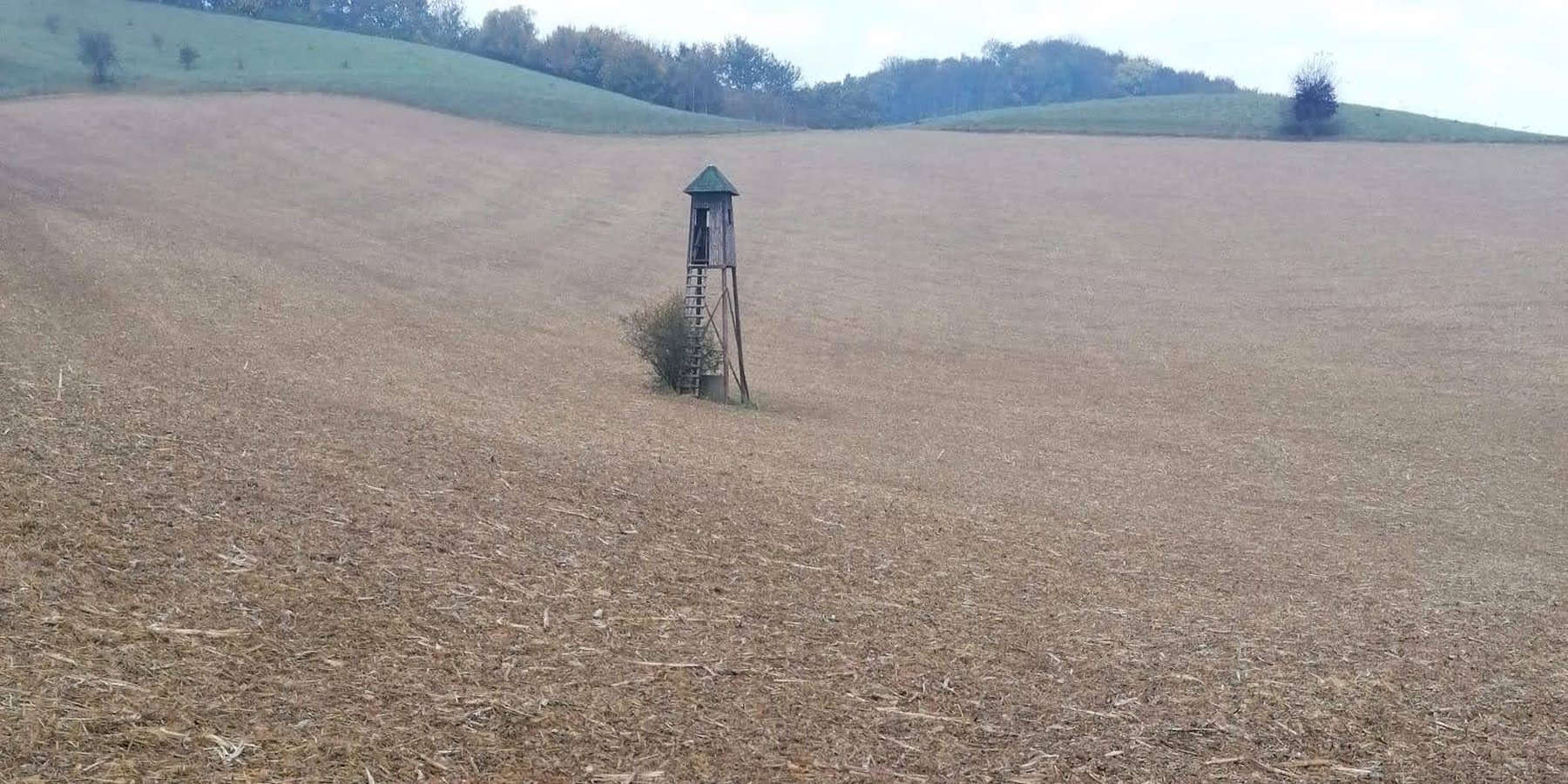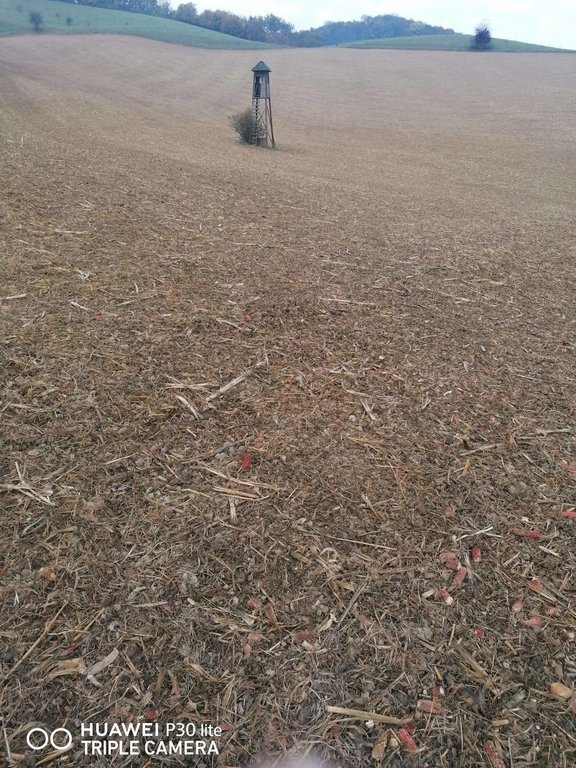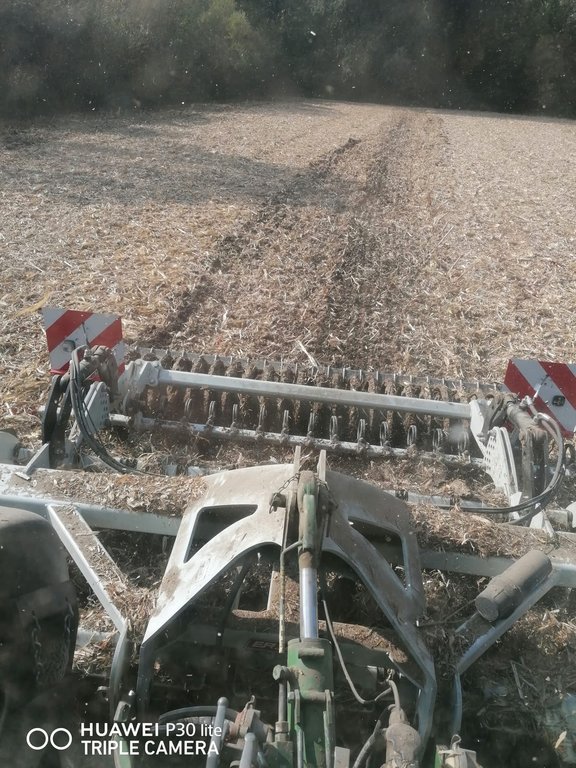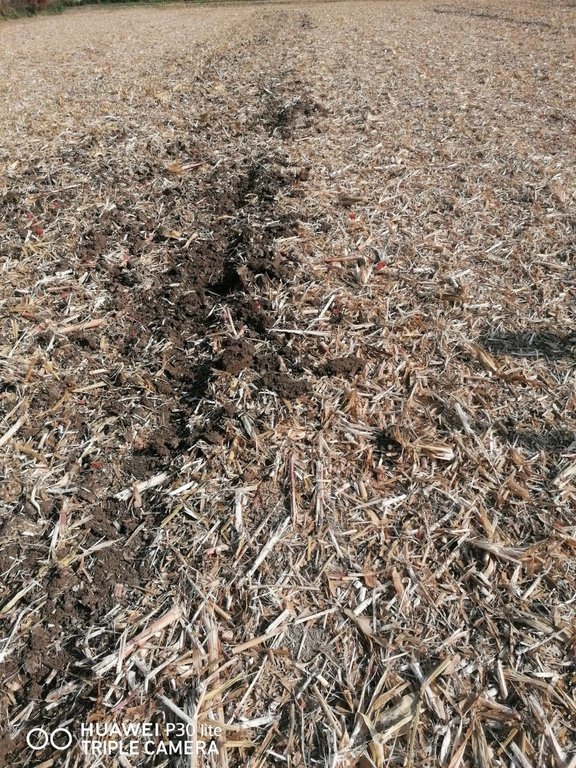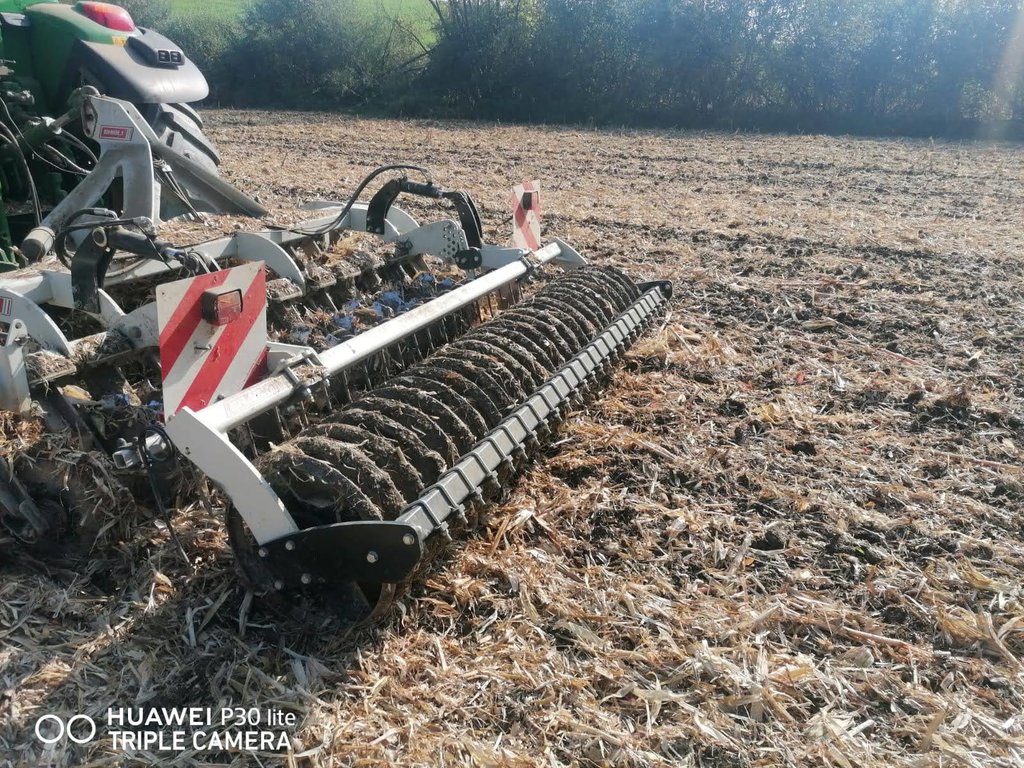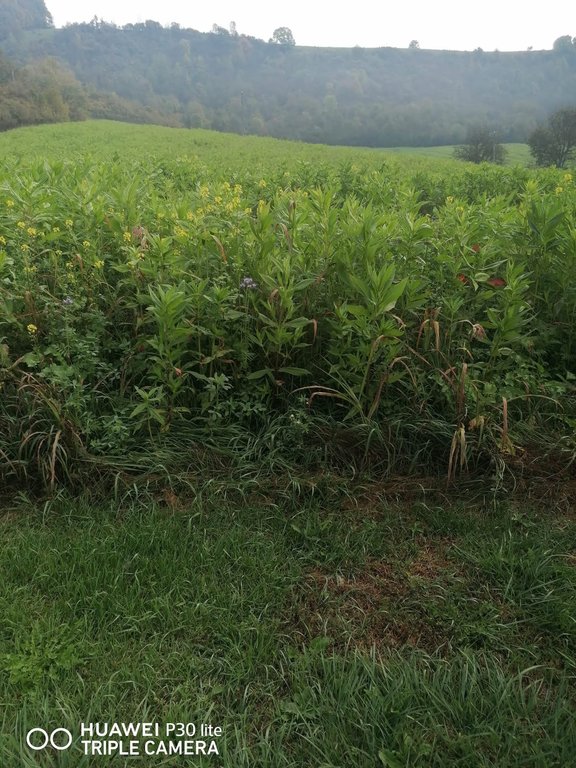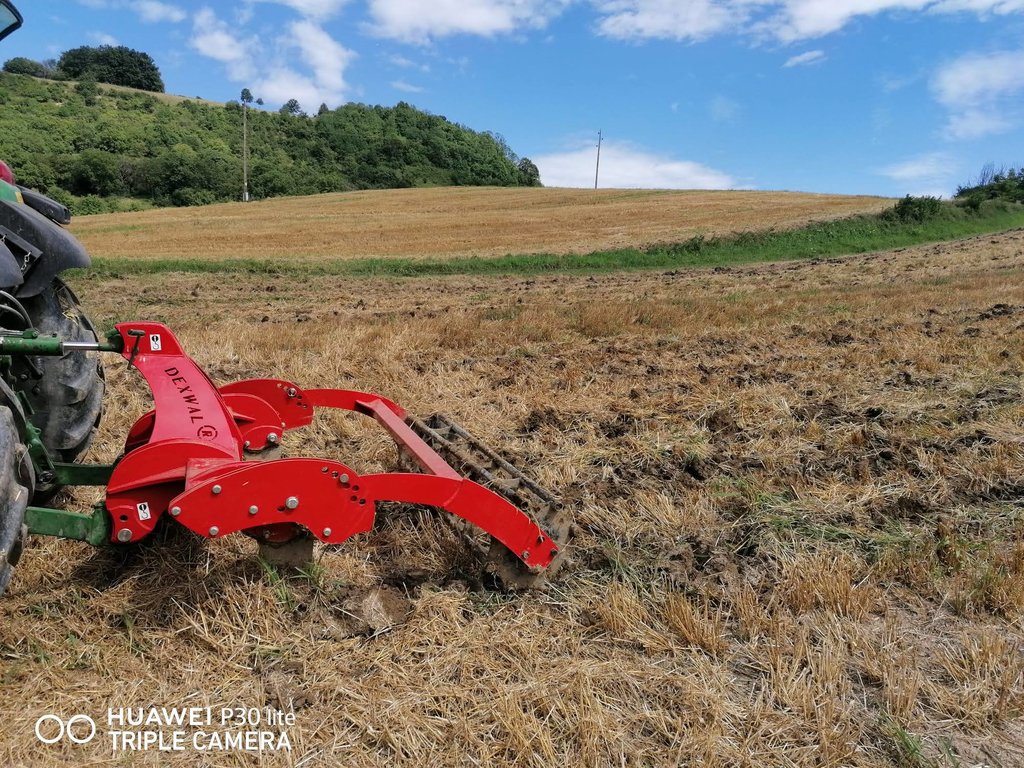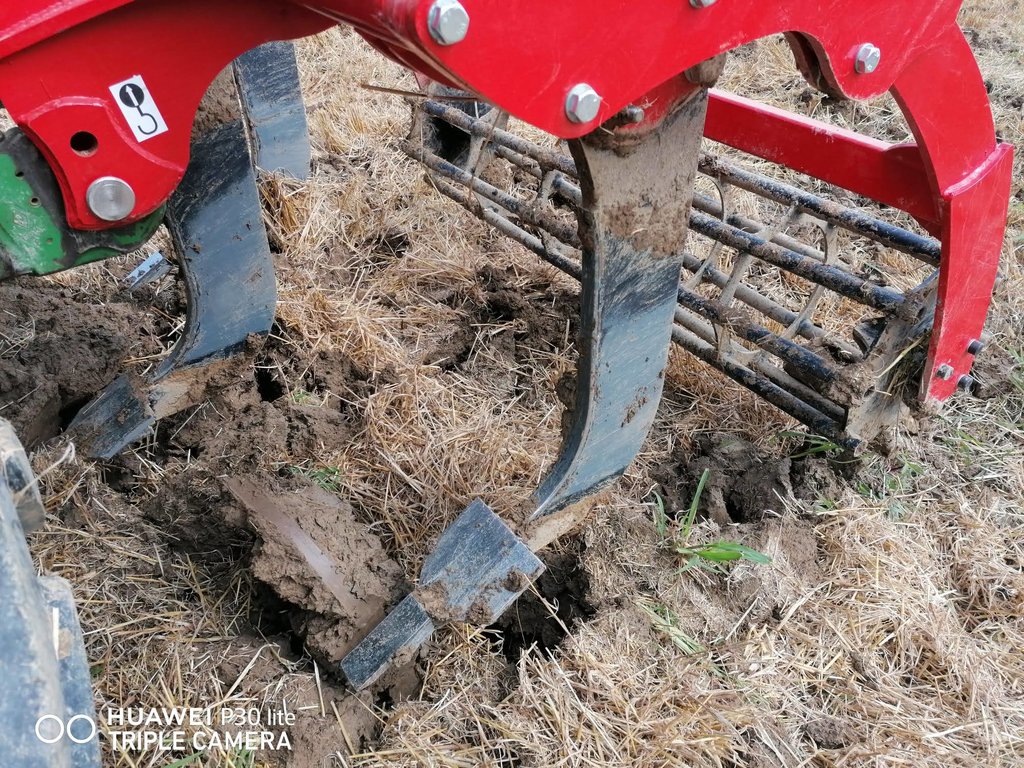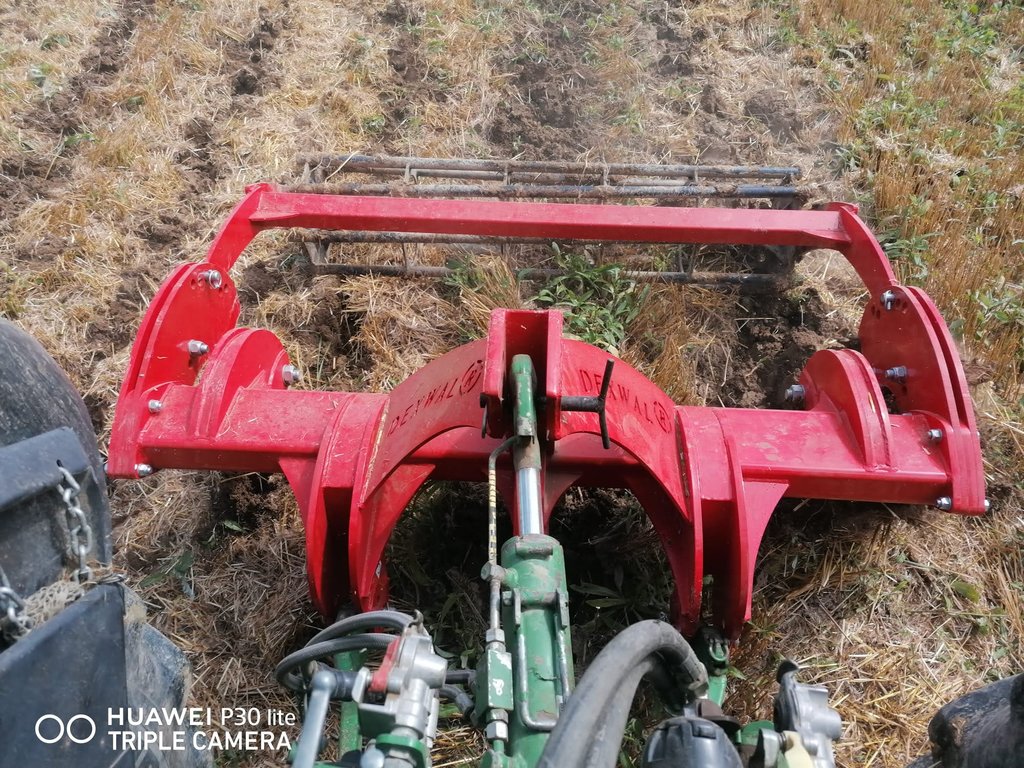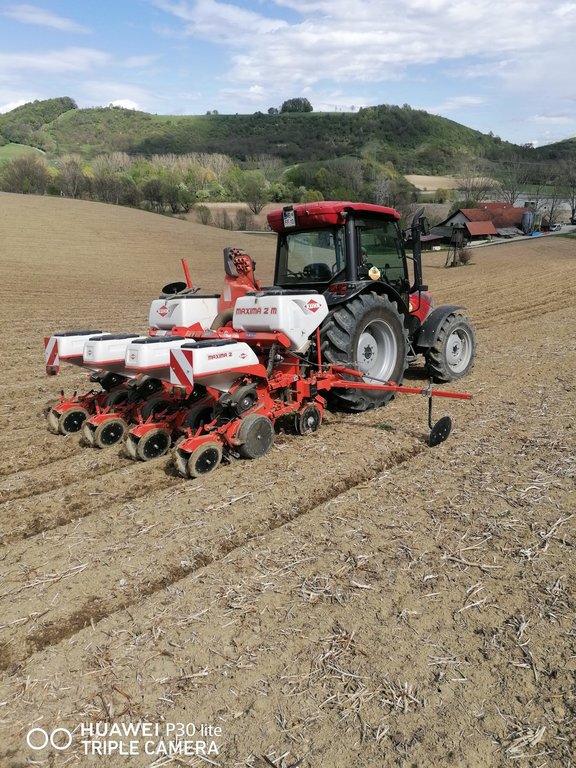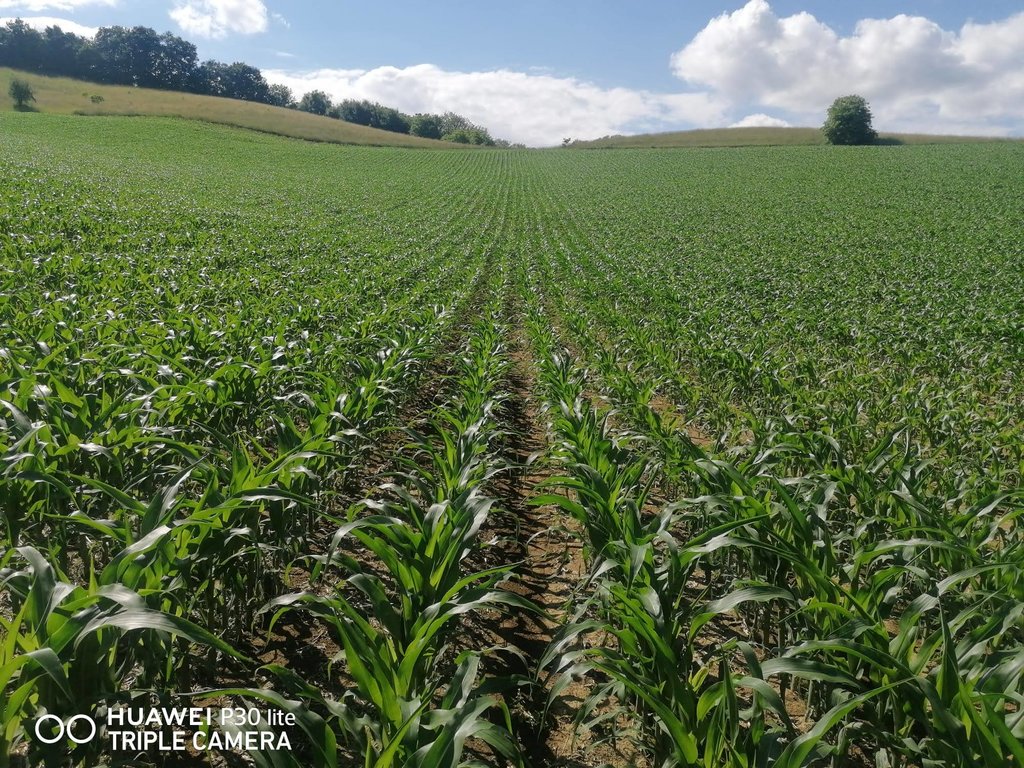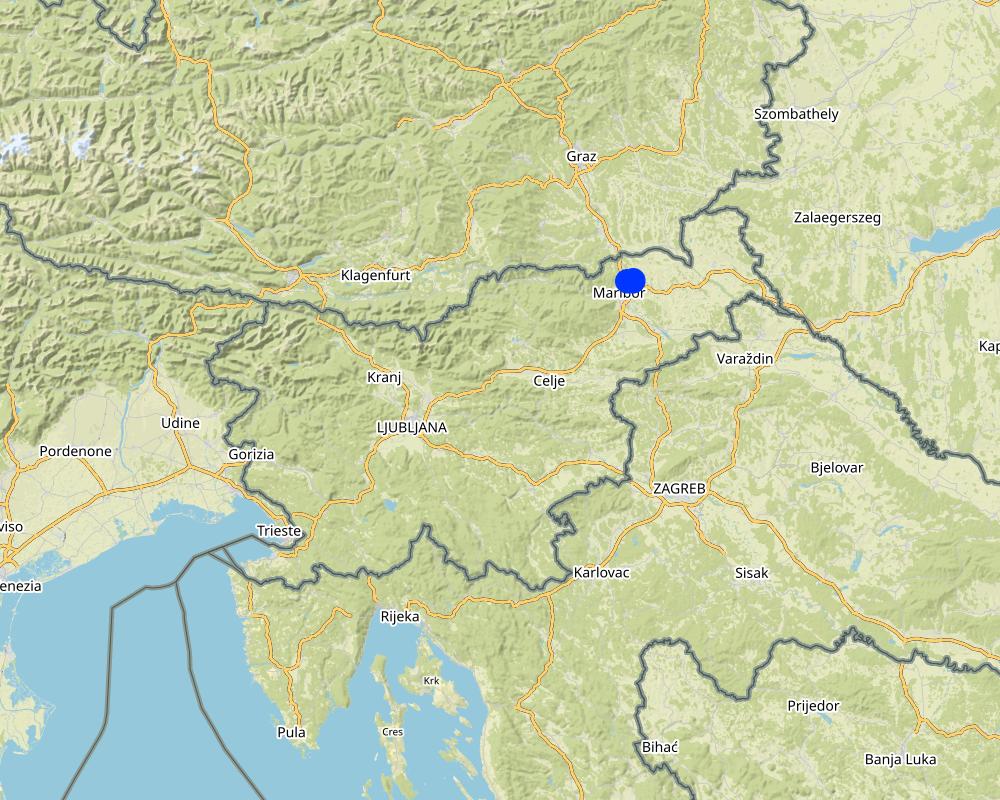Mulch-till [Slovenia]
- Creation:
- Update:
- Compiler: Gregor Kramberger
- Editor: Matjaz Glavan
- Reviewers: William Critchley, Rima Mekdaschi Studer
Konzervirajoča obdelava tal (mulch-till)
technologies_6241 - Slovenia
View sections
Expand all Collapse all1. General information
1.2 Contact details of resource persons and institutions involved in the assessment and documentation of the Technology
Key resource person(s)
SLM specialist:
SLM specialist:
SLM specialist:
Curk Miha
Biotechnical Faculty, University of Ljubljana
Slovenia
SLM specialist:
Cvejic Rozalija
Biotechnical Faculty, University of Ljubljana
Slovenia
land user:
Ropič Andrej
Farmer
Slovenia
1.3 Conditions regarding the use of data documented through WOCAT
The compiler and key resource person(s) accept the conditions regarding the use of data documented through WOCAT:
Yes
1.4 Declaration on sustainability of the described Technology
Is the Technology described here problematic with regard to land degradation, so that it cannot be declared a sustainable land management technology?
No
2. Description of the SLM Technology
2.1 Short description of the Technology
Definition of the Technology:
Mulch-till is a method of farming that does not utilise a plough, and thus the soil is not turned over. Furthermore, at least 30% of the cultivated area remains covered with organic residues left over from the previous crop. There are multiple benefits to the soil and carbon dioxide emissions are reduced.
2.2 Detailed description of the Technology
Description:
Mulch-till (also called “conservation agriculture” or “minimum tillage”) is a method of land management with modified, less intensive tillage, where land is covered with plant residues year-round (at least 30% cover) or grass, energy consumption is reduced, and there is less trampling/ compaction of the soil because of fewer machine passes and the protected surface. Under mulch-till, special agricultural machinery and attachments are required. Disc harrows and chisel ploughs are used to loosen the soil, and direct drills are employed for seeding. Ploughs are not used and the soil is not inverted. This method of tillage is intended to maintain soil structure, build up humus, improve nutrient supply and soil moisture, increase soil microbiological activity and also to prevent soil erosion. Mulch-till reduces the number of work operations on the cultivated area. Because the soil is disturbed less, this minimises the exposure of soil organic matter to the air, and therefore decreases the formation and release of CO2 to the atmosphere.
The debate over whether ploughing is still necessary has been going on for quite some time. Both mulch-till and ploughing have their advantages as well as disadvantages. Research shows that mulch-till reduces soil erosion and compaction, and this has a significant impact on soil fertility. On the other hand, ploughing better inhibits the spread of weeds and certain types of diseases and pests.
Mulch-till requires complete replacement of machines/tools, and this is a considerable initial investment. Regular annual maintenance of the equipment is needed also. Mulch-till provides full benefits after a number of years, through making sure that minimal soil inversion and organic soil coverage is guaranteed. It also requires good planning of crop rotation, the use of a special seed drill and employment of herbicides after emergence (or surface hoeing). Users mention one advantage being the low costs for tillage, which is less expensive than ploughing, and the reduction of soil erosion on sloping terrain. However, they do not like the high investment for equipment, possible lost of yields and increase in weeds: all tend to arise at the beginning of implementation. Knowledge and experience are required, as the technology is quite demanding, so there are chances of failure.
2.3 Photos of the Technology
General remarks regarding photos:
Mulch tillage technique and sowing of maize at the Ropič farm.
2.5 Country/ region/ locations where the Technology has been applied and which are covered by this assessment
Country:
Slovenia
Region/ State/ Province:
Jareninski dol, Pernica
Further specification of location:
Vosek
Specify the spread of the Technology:
- evenly spread over an area
If precise area is not known, indicate approximate area covered:
- < 0.1 km2 (10 ha)
Is/are the technology site(s) located in a permanently protected area?
No
Map
×2.6 Date of implementation
Indicate year of implementation:
2020
2.7 Introduction of the Technology
Specify how the Technology was introduced:
- through land users' innovation
- during experiments/ research
Comments (type of project, etc.):
A few years ago, the farmer transitioned from traditional plowing to a mulch-tillage technique and has been using this method since 2020. In 2021, the farmer sought assistance from a consulting service to connect with the Biotechnical faculty in Ljubljana. Tests were conducted to assess the impact of conservation tillage. Following the positive results, the farmer has continued collaborating with the Biotechnical faculty and the public advisory service, further experimenting with the technology and maintaining the new cultivation approach. Today, he is one of the prominent advocates of conservation tillage.
3. Classification of the SLM Technology
3.1 Main purpose(s) of the Technology
- reduce, prevent, restore land degradation
- protect a watershed/ downstream areas – in combination with other Technologies
- reduce risk of disasters
- adapt to climate change/ extremes and its impacts
- mitigate climate change and its impacts
3.2 Current land use type(s) where the Technology is applied
Land use mixed within the same land unit:
No

Cropland
- Annual cropping
Annual cropping - Specify crops:
- cereals - barley
- cereals - maize
- cereals - wheat (winter)
- fodder crops - clover
- fodder crops - other
- legumes and pulses - other
- legumes and pulses - soya
Number of growing seasons per year:
- 1
Is intercropping practiced?
No
Is crop rotation practiced?
Yes
If yes, specify:
Continuously 1 main crop: maize, wheat (winter) or barely (winter) and fodder peas or soy. After the main crop, the rotation includes cover crops (greening) which consist of mixtures of plants such as phacelia, clover, mung bean, etc.
3.3 Has land use changed due to the implementation of the Technology?
Has land use changed due to the implementation of the Technology?
- No (Continue with question 3.4)
3.4 Water supply
Water supply for the land on which the Technology is applied:
- rainfed
3.5 SLM group to which the Technology belongs
- improved ground/ vegetation cover
- minimal soil disturbance
- integrated soil fertility management
3.6 SLM measures comprising the Technology

agronomic measures
- A1: Vegetation/ soil cover
- A2: Organic matter/ soil fertility
- A3: Soil surface treatment
- A6: Residue management
A3: Differentiate tillage systems:
A 3.2: Reduced tillage (> 30% soil cover)
A6: Specify residue management:
A 6.4: retained
3.7 Main types of land degradation addressed by the Technology

soil erosion by water
- Wt: loss of topsoil/ surface erosion
- Wg: gully erosion/ gullying

chemical soil deterioration
- Cn: fertility decline and reduced organic matter content (not caused by erosion)

physical soil deterioration
- Pc: compaction

biological degradation
- Bc: reduction of vegetation cover
- Bq: quantity/ biomass decline
- Bl: loss of soil life
3.8 Prevention, reduction, or restoration of land degradation
Specify the goal of the Technology with regard to land degradation:
- prevent land degradation
- reduce land degradation
4. Technical specifications, implementation activities, inputs, and costs
4.1 Technical drawing of the Technology
Technical specifications (related to technical drawing):
Whether it is low-till or conventional tillage depends on the tool use during soil tillage and how we use it. There are many implementation variants of conservation tillage that go by different professional names and definitions. Low-till is defined according to the depth of tillage, the intensity of soil layer mixing, the coverage of soil surface with harvest (organic) residues or intermediate tillage residues, according to the way tools move on the soil and the number of machine operations that are performed individually or combined (basic tillage, soil loosening seedbed preparation, pre-sowing tillage, sowing, ...). We focus on one version of low-till that we estimate has the greatest chances of being established in a short time in the case study area, which is so called »mulch-till«. We will concentrate on the term »mulch-till« which we define as a medium deep (10 cm) conservation tillage technique using chisel plow in combination with disk harrow. The coverage of the soil surface with residues must be at least 30% or higher. In addition, a special seeder is required to carry out "mulch" sowing (with moving parts). The success of mulch-till also depends on the combination with other implemented measures like crop rotation, cover crops, etc.
Author:
Bodenbear beitung und Bestellung
Date:
2015
4.2 General information regarding the calculation of inputs and costs
Specify how costs and inputs were calculated:
- per Technology area
Indicate size and area unit:
1 ha
If using a local area unit, indicate conversion factor to one hectare (e.g. 1 ha = 2.47 acres): 1 ha =:
1 ha = 10,000 m2
other/ national currency (specify):
EUR
If relevant, indicate exchange rate from USD to local currency (e.g. 1 USD = 79.9 Brazilian Real): 1 USD =:
0.97
Indicate average wage cost of hired labour per day:
90.90
4.3 Establishment activities
| Activity | Timing (season) | |
|---|---|---|
| 1. | Purchase of 2-row disc harrow | 1st year |
| 2. | Purchase deep chisel plow | 1st year |
| 3. | Purchase pneumatic seed drill combined with rotary harrow | 1st year |
| 4. | Purchase pneumatic precision planter with rotating elements | 1st year |
| 5. | Purchase cover crop seed drill | 1st year |
Comments:
Tractor should also be considered as part of the investment in implementing the mulch-till technology. The required tractor for operating Mulch-till is at least 110 HP. Let's assume a tractor with four-wheel drive, 95–125 kW (129–170 HP), with an investment cost of 66,400 €. Its usage should be economically justified for the entire farm (used for all farm tasks).
4.4 Costs and inputs needed for establishment
| Specify input | Unit | Quantity | Costs per Unit | Total costs per input | % of costs borne by land users | |
|---|---|---|---|---|---|---|
| Equipment | Purchase of 2-row disc harrow | piece | 29.7 | 404.0404 | 12000.0 | 100.0 |
| Equipment | Purchase deep chisel plow | piece | 29.7 | 101.0101 | 3000.0 | 100.0 |
| Equipment | Pneumatic seed drill combined with rotary harrow | piece | 29.7 | 909.0909 | 27000.0 | 100.0 |
| Equipment | Pneumatic precision planter with rotating elements | piece | 29.7 | 572.3905 | 17000.0 | 100.0 |
| Equipment | Cover crop seed drill | piece | 29.7 | 151.5151 | 4500.0 | 100.0 |
| Total costs for establishment of the Technology | 63500.0 | |||||
| Total costs for establishment of the Technology in USD | 65463.92 | |||||
Comments:
The estimated lifespan of the equipment represents only an illustrative measure in terms of total hours, hectares, or machine work until its obsolescence. This data is not considered in the cost calculation. It is generally not economically viable to use a machine until its complete obsolescence, as it may become technologically outdated or require excessive investment for restoration compared to its economic usage. It is more sensible to use the machine's depreciation period. The average depreciation value is determined based on the average annual usage of the machine. The depreciation period for attachments is 12 years.
4.5 Maintenance/ recurrent activities
| Activity | Timing/ frequency | |
|---|---|---|
| 1. | Tractor operation and maintanance | It is used for all operations related to the technology (without cover crop seed drill operation).. |
| 2. | Deep chisel plow operation and maintanance | 1 time per 5 years, on all cultivated field surfaces (29,7 ha), 1.0 h/ha. |
| 3. | 2-row disc harrow operation and maintanance | 2 time per year, on all cultivated field surfaces (29,7 ha), 0.8 h/ha. |
| 4. | Pneumatic precision planter with rotating elements operation and maintanance | 1 times per year, on 50 % of all cultivated field surfaces (14.85 ha), 1.3 h/ha. |
| 5. | Cover crop seed drill operation and maintanance | 1 time per year, on all cultivated field surfaces (29,7 ha), 0.8 h/ha (combined with harrow). |
| 6. | Pneumatic seed drill combined with rotary harrow operation and maintanance | 1 times per year, on 50 % of all cultivated field surfaces (14,85 ha), 1.4 h/ha. |
| 7. | Purchase cover crop seed mixture Fruh | 1 time per year, on all cultivated field surfaces (29,7 ha). |
4.6 Costs and inputs needed for maintenance/ recurrent activities (per year)
| Specify input | Unit | Quantity | Costs per Unit | Total costs per input | % of costs borne by land users | |
|---|---|---|---|---|---|---|
| Labour | Tractor operation | EUR/ha | 29.7 | 18.144 | 538.88 | 100.0 |
| Labour | Machine maintenance | EUR/ha | 29.7 | 2.88 | 85.54 | 100.0 |
| Equipment | Machine avarage total costs of tractor operation and maintanance | EUR/ha | 29.7 | 122.598 | 3641.16 | 100.0 |
| Equipment | Machine avarage total costs of deep chisel plow operation and maintanance | EUR/ha | 29.7 | 4.36 | 129.49 | 100.0 |
| Equipment | Machine avarage total costs of 2-row disc harrow operation and maintanance | EUR/ha | 29.7 | 30.432 | 903.83 | 100.0 |
| Equipment | Machine avarage total costs of pneumatic precision planter with rotating elements operation and maintanance | EUR/ha | 14.85 | 29.744 | 441.7 | 100.0 |
| Equipment | Machine avarage total costs of cover crop seed drill operation and maintanance | EUR/ha | 29.7 | 2.872 | 85.3 | 100.0 |
| Equipment | Machine avarage total costs of Pneumatic seed drill combined with rotary harrow operation and maintanance | EUR/ha | 14.85 | 52.416 | 778.38 | 100.0 |
| Plant material | Cover crop mixture Fruh | EUR/ha | 29.7 | 66.768 | 1983.01 | 100.0 |
| Total costs for maintenance of the Technology | 8587.29 | |||||
| Total costs for maintenance of the Technology in USD | 8852.88 | |||||
4.7 Most important factors affecting the costs
Describe the most determinate factors affecting the costs:
It very much depends on the type of soil, what is the structure of the soil. In addition, the planning of the crop rotation and cover crops also affect the costs. As a result, weed development and subsequent herbicide use may be different.
5. Natural and human environment
5.1 Climate
Annual rainfall
- < 250 mm
- 251-500 mm
- 501-750 mm
- 751-1,000 mm
- 1,001-1,500 mm
- 1,501-2,000 mm
- 2,001-3,000 mm
- 3,001-4,000 mm
- > 4,000 mm
Specify average annual rainfall (if known), in mm:
1015.00
Specifications/ comments on rainfall:
The most precipitation falls in summer, the months with the highest average precipitation are June and August, the least precipitation falls in winter, in January and February at least, and in principle more precipitation falls in autumn than in spring.
Indicate the name of the reference meteorological station considered:
Jareninski vrh (1981 – 2010)
Agro-climatic zone
- sub-humid
Mean annual temperature in year 2014 Jareninski vrh is 11,9°C.
5.2 Topography
Slopes on average:
- flat (0-2%)
- gentle (3-5%)
- moderate (6-10%)
- rolling (11-15%)
- hilly (16-30%)
- steep (31-60%)
- very steep (>60%)
Landforms:
- plateau/plains
- ridges
- mountain slopes
- hill slopes
- footslopes
- valley floors
Altitudinal zone:
- 0-100 m a.s.l.
- 101-500 m a.s.l.
- 501-1,000 m a.s.l.
- 1,001-1,500 m a.s.l.
- 1,501-2,000 m a.s.l.
- 2,001-2,500 m a.s.l.
- 2,501-3,000 m a.s.l.
- 3,001-4,000 m a.s.l.
- > 4,000 m a.s.l.
Indicate if the Technology is specifically applied in:
- concave situations
Comments and further specifications on topography:
There are depressions, settlements are in the valley, concave type.
5.3 Soils
Soil depth on average:
- very shallow (0-20 cm)
- shallow (21-50 cm)
- moderately deep (51-80 cm)
- deep (81-120 cm)
- very deep (> 120 cm)
Soil texture (topsoil):
- medium (loamy, silty)
Soil texture (> 20 cm below surface):
- medium (loamy, silty)
Topsoil organic matter:
- medium (1-3%)
5.4 Water availability and quality
Ground water table:
5-50 m
Availability of surface water:
good
Water quality (untreated):
for agricultural use only (irrigation)
Water quality refers to:
surface water
Is water salinity a problem?
No
Is flooding of the area occurring?
Yes
Regularity:
episodically
Comments and further specifications on water quality and quantity:
Hydromelioration was carried out in the area, a drainage system and water retention systems (e.g. ponds and basins) were arranged.
5.5 Biodiversity
Species diversity:
- medium
Habitat diversity:
- medium
5.6 Characteristics of land users applying the Technology
Sedentary or nomadic:
- Sedentary
Market orientation of production system:
- commercial/ market
Off-farm income:
- 10-50% of all income
Relative level of wealth:
- average
Individuals or groups:
- individual/ household
Level of mechanization:
- mechanized/ motorized
Gender:
- men
Age of land users:
- middle-aged
5.7 Average area of land used by land users applying the Technology
- < 0.5 ha
- 0.5-1 ha
- 1-2 ha
- 2-5 ha
- 5-15 ha
- 15-50 ha
- 50-100 ha
- 100-500 ha
- 500-1,000 ha
- 1,000-10,000 ha
- > 10,000 ha
Is this considered small-, medium- or large-scale (referring to local context)?
- medium-scale
5.8 Land ownership, land use rights, and water use rights
Land ownership:
- individual, titled
Land use rights:
- leased
- individual
Water use rights:
- communal (organized)
Are land use rights based on a traditional legal system?
No
Specify:
based on national legal system
5.9 Access to services and infrastructure
health:
- poor
- moderate
- good
education:
- poor
- moderate
- good
technical assistance:
- poor
- moderate
- good
employment (e.g. off-farm):
- poor
- moderate
- good
markets:
- poor
- moderate
- good
energy:
- poor
- moderate
- good
roads and transport:
- poor
- moderate
- good
drinking water and sanitation:
- poor
- moderate
- good
financial services:
- poor
- moderate
- good
6. Impacts and concluding statements
6.1 On-site impacts the Technology has shown
Socio-economic impacts
Production
crop production
Comments/ specify:
Some farmers report a slight drop in yield in first years after the implementation of the measure, but the farmer in the case study location didn't notice any difference in yield.
risk of production failure
Comments/ specify:
Reduced risk, but with the wrong approach it can increase. For example, reduced risk due to unfavorable weather conditions, increased risk due to the possibility of weed development.
land management
Comments/ specify:
Simplified soil tillage technology.
Income and costs
expenses on agricultural inputs
Comments/ specify:
Reduced costs due to lower energy (fuel) consumption.
workload
Comments/ specify:
Fewer hours dedicated for tillage.
Socio-cultural impacts
food security/ self-sufficiency
Comments/ specify:
Facilitated production with lower costs, motivation to do business in agriculture.
SLM/ land degradation knowledge
Comments/ specify:
With positive effects more interest of the farmer in sustainable production.
Ecological impacts
Water cycle/ runoff
surface runoff
evaporation
Soil
soil moisture
soil cover
soil loss
soil accumulation
soil crusting/ sealing
soil compaction
nutrient cycling/ recharge
soil organic matter/ below ground C
Biodiversity: vegetation, animals
Vegetation cover
biomass/ above ground C
plant diversity
invasive alien species
animal diversity
Comments/ specify:
Cover crops act as hiding places for various animals.
beneficial species
Comments/ specify:
Plants attract pollinators.
habitat diversity
Climate and disaster risk reduction
drought impacts
emission of carbon and greenhouse gases
6.2 Off-site impacts the Technology has shown
buffering/ filtering capacity
Comments/ specify:
Surface cover with plants.
damage on public/ private infrastructure
Comments/ specify:
The soil is not carried into ditches and ponds.
6.3 Exposure and sensitivity of the Technology to gradual climate change and climate-related extremes/ disasters (as perceived by land users)
Gradual climate change
Gradual climate change
| Season | increase or decrease | How does the Technology cope with it? | |
|---|---|---|---|
| annual rainfall | decrease | well |
Climate-related extremes (disasters)
Meteorological disasters
| How does the Technology cope with it? | |
|---|---|
| local rainstorm | very well |
Climatological disasters
| How does the Technology cope with it? | |
|---|---|
| heatwave | well |
| drought | well |
Hydrological disasters
| How does the Technology cope with it? | |
|---|---|
| landslide | very well |
6.4 Cost-benefit analysis
How do the benefits compare with the establishment costs (from land users’ perspective)?
Short-term returns:
slightly negative
Long-term returns:
positive
How do the benefits compare with the maintenance/ recurrent costs (from land users' perspective)?
Short-term returns:
positive
Long-term returns:
positive
Comments:
The initial establishment and investment costs for implementing the technology are high, and in the short term, the benefits may not be very noticeable or even negative compared to conservative technology. However, the long-term benefits are more significant and positive. While there are recurring costs involved, such as maintenance expenses, they are considerably lower compared to the initial investment costs. The technology requires substantial upfront investment in equipment, which can initially outweigh the immediate returns. It takes time for the technology to mature and for the full benefits to be realized. As the system becomes established and optimized, the positive outcomes become more apparent over the long run. Additionally, the lower costs mentioned refer to the ongoing maintenance and operational expenses required to sustain the technology (machines), which are generally lower than the initial investment costs. These costs are often outweighed by the benefits gained from improved efficiency, reduced resource consumption, and other long-term advantages. Therefore, while the short-term returns may not be overwhelmingly positive, the investment in the technology pays off over time, with greater benefits and lower operational costs.
6.5 Adoption of the Technology
- 1-10%
Of all those who have adopted the Technology, how many did so spontaneously, i.e. without receiving any material incentives/ payments?
- 91-100%
6.6 Adaptation
Has the Technology been modified recently to adapt to changing conditions?
Yes
other (specify):
added equipment/mechanization attachments to facilitate technology implementation, improved technology implementation with knowledge and experience
Specify adaptation of the Technology (design, material/ species, etc.):
Added cover crop seed drill. more emphasis on cover crop.
6.7 Strengths/ advantages/ opportunities of the Technology
| Strengths/ advantages/ opportunities in the land user’s view |
|---|
| Less depression, erosion and soil leaching. |
| Cost and time (fewer passes, machine hours, less machine power required). |
| Care for nature, sustain natural resources. |
| Strengths/ advantages/ opportunities in the compiler’s or other key resource person’s view |
|---|
| In the long term it enables the achievement of better soil conditions, in terms of appropriate ratios of water, air, nutrients, organic matter, microbial activity, pH, microbial activity, pH and other factors of soil fertility. |
| Compaction and drying of the top layer of the soil is significantly less frequent and as a result losses of young plants are therefore smaller. |
| It reduces the potential for soil erosion. A major threat to soil fertility is erosion processes (wind, water and other erosion), where the most fertile surface layers of the soil are carried away to other parts of the ecosystem that are not intended for food production. |
| It brings advantages in terms of energy consumption and the possibility of carrying out production tasks in a shorter time and in difficult weather conditions. Conservation tillage tools typically operate in a shallower soil layer and mix less soil mass, it enables the use of tools with larger working widths and thus less unproductive driving in the field. |
| Benefits in terms of reduced transfer of phytopharmaceuticals and nutrients excess from the cultivation area to water and other ecosystems. |
| Reduced tillage improves soil quality, reduces nutrient leaching and lowers greenhouse gas emissions. |
| Benefits in terms of bioavailability and nutrient uptake efficiency. |
| Benefits in terms of greater adaptability of crops to extreme weather events. |
| Benefits in terms of maintaining the overall biological diversity of the agricultural landscape and soil. |
6.8 Weaknesses/ disadvantages/ risks of the Technology and ways of overcoming them
| Weaknesses/ disadvantages/ risks in the land user’s view | How can they be overcome? |
|---|---|
| A big investment in machinery. | It is possible to start gradually with cheaper and simpler machines (also home-made). |
| Adaptation of crop protection. | Implementing integrated pest management (IPM). |
| Weaknesses/ disadvantages/ risks in the compiler’s or other key resource person’s view | How can they be overcome? |
|---|---|
| An increase in the occurrence of certain types of weeds and a high dependence on certain types of herbicides. Some studies show that the introduction of conservation tillage slightly increases losses from certain diseases and pests. | For successful weed control, it is important to have a varied crop rotation, frequent sowing of cover crops and intercrops, and that the weeds never leave uncontrolled development on the stubble. The variegated crop rotation is meant as an obstacle that interrupts the development cycle of diseases and pests. How we handle harvest residues is also important. The more finely they are chopped by combines, mulchers or tools for vertical tillage before sowing, the faster they decompose and the worse the chances of harmful organisms developing on them. An evenly distributed mulch of harvest residues should remain, which prevents the emergence of new waves of weeds. These additional measures, together with mechanical weed control with new types of tools, allow limiting the weed population to a level that can be controlled with a limited range of herbicides. |
| Investment costs in machines designed for the method of soil cultivation can be very high. An important obstacle in the introduction of conservation tillage is the large investments in new machinery... The value of purchasing these tools can well exceed the amount of 100,000 euros for an individual farm, which is a practically unfeasible investment for small farms. | Small farms can take the transition to conservation farming only with the help of hired machinery services from neighbouring large farms that have been able to invest in new equipment. The subsidization of the purchase of machinery and also the economic legal status of the farm in terms of VAT calculation play an important role. |
| It is necessary to replace all the tools used by farmers according to the old methods of tillage. It is necessary to purchase adapted cultivators, harrows, looseners and especially seeder drills. | Increase in the supply of relatively inexpensive machines from manufacturers from Eastern Europe and Turkey, which can increase the availability of this equipment to smaller farms. |
| In the first years of the transition period, there may be a significant reduction in yields and poor financial results. There is a yield reduction and financial stress during the transition period to the new system. The transition from conventional cultivation to conservation tillage is usually difficult and risky. | Growers must be financially strong in order to make the transition, and the areas under alternative cultivation systems must increase gradually when they really master the new cultivation technique. Good financial support during the transition period is very important for small farms with weak investment assets. Targeted education and training is necessary, as technological errors due to lack of knowledge regarding the implementation of conservation cultivation in different soil types can be economically very fatal. |
| A small increase in the seeding rate (10 to 15 %) is often recommended to compensate for losses caused by diseases and pests at the time of plant emergence. | A necessary cost that must be accepted (higher sowing rate for the main crops and additional crops – cover crops) for the successful implementation of the measure. |
7. References and links
7.1 Methods/ sources of information
- interviews with land users
1 farmer (Andrej Ropič)
- interviews with SLM specialists/ experts
3 (Biotechnical Faculty; Matjaž Glavan, Miha Curk, and Rozalija Cvejič)
- compilation from reports and other existing documentation
2 (we utilized the following documents: "ANALYSIS OF ECONOMIC EFFICIENCY OF ALTERNATIVE AGRONOMIC PRACTICE (AAP) ON VVO" by Črtomir Rozman, Karmen Pažek, Mario Lešnik, and "Bodenbearbeitung und Bestellung Definition von Bodenbearbeitungs- und Bestellsystemen" (translated to English as "Tillage and cultivation Definition of tillage and cultivation systems") by Dr. Joachim Bischoff et al.)
When were the data compiled (in the field)?
17/01/2023
Comments:
Visit to the farm and farmer interview. A working group was established, where we met 2 times to review and respond to the questionnaire.
7.2 References to available publications
Title, author, year, ISBN:
TJ Townsend, SJ Ramsden, P Wilson. Analysing reduced tillage practices within a bio-economic modelling framework. Agricultural Systems 146 (2016) 91–102.
Available from where? Costs?
ScienceDirect
Title, author, year, ISBN:
E Houshyar, MJ SheikhDavoodi, M Almassi, H Bahrami, H Azadi, M Omidi, G Sayyad, F Witlox. Silage corn production in conventional and conservation tillage systems. Part I: Sustainability analysis using combination of GIS/AHP and multi-fuzzy modeling. Ecological Indicators 39 (2014) 102–114.
Available from where? Costs?
ScienceDirect
7.3 Links to relevant online information
Title/ description:
C Rozman, K Pažek, M Lešnik. Analiza ekonomske ucinkovitosti alternativne agronomske prakse (AAP) na VVO. Univerza v Mariboru, Fakulteta za kmetijstvo in biosistemske vede, 2018.
URL:
https://www.google.com/url?sa=t&rct=j&q=&esrc=s&source=web&cd=&ved=2ahUKEwjNtpH7peD8AhWFzaQKHdPXBM4QFnoECAYQAQ&url=https%3A%2F%2Fwww.kgzs-ms.si%2Fwp-content%2Fuploads%2F2018%2F07%2FD.T3.3.1-Study-final-May-2018.pdf&usg=AOvVaw3qni6nXmwUM25mhI0FwPln
Title/ description:
Mimalna obdelava tal – praktični primeri na naših kmetijah (žipo, ropic, horvat)
URL:
https://www.google.com/url?sa=t&rct=j&q=&esrc=s&source=web&cd=&cad=rja&uact=8&ved=2ahUKEwiZ6smRpuD8AhWrsaQKHcRSBoMQFnoECAkQAQ&url=https%3A%2F%2Fwww.kmetijski-zavod.si%2FPortals%2F0%2Flombergarjevi%2FMinimalna%2520obdelava%2520tal%2520%25E2%2580%2593%2520prakti%25C4%258Dni%2520primeri%2520na%2520na%25C5%25A1ih%2520kmetijah%2520%5BSamodejno%2520shranjeno%5D.pdf%3Fver%3D2021-12-13-094249-623&usg=AOvVaw1jtWGuL4ovgrvC0rvqm1iS
Links and modules
Expand all Collapse allLinks
No links
Modules
No modules


